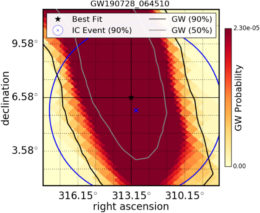The universe is crackling with gravitational waves and sparkling with neutrino emissions, but detecting both signals from the same source is an enormous challenge. A new publication summarizes the state of this effort and reports on non-detections of high-energy neutrinos associated with the merger events caught by LIGO/Virgo.
Multiple Messengers
Historically, astronomers studied our universe by analyzing the electromagnetic radiation (light) that lands on Earth after a journey through the depths of the cosmos. In the last decade, however, researchers have expanded upon this paradigm and now routinely scrutinize other “messengers” that collide with our home planet and leave their imprints on our scientific instruments. Two of these messengers include high-energy neutrinos, first observed in 2013, and gravitational waves, first spotted in 2015.
Certain astrophysical processes, including the mergers of compact objects like black holes and neutron stars, are thought to produce both of these messengers. Therefore, to wring as much information as possible from these distant events, astronomers are incentivized to detect coincident signals of different messengers from the same source. Unfortunately, pulling this off requires overcoming technical and instrumental hurdles across two different subfields of physics, and to date the positional uncertainties of gravitational wave detections especially have prevented any confident claims.
Vigilance and Patience

The distribution of delay times between a gravitational wave event and release of preliminary IceCube analysis. Most often the team turned around results in less than one hour. [Abbasi et al. 2023]
The IceCube team, a collaboration that searches for flashes of light created when high-energy neutrinos interact with Antarctic ice, watched carefully for these real-time estimates. Whenever one was released, they immediately checked their logs for high-energy neutrinos that came around the same time from around the same place as the gravitational wave, then released their own reports of any encouraging signals. Thanks to their preparation leading up to the run, this entire process happened usually within the hour following the initial LIGO/Virgo observations. Once the runs were complete and the gravitational wave data were collated into a more confident catalog, the team also ran an after-the-fact analysis to check if anything was missed in real time.
Close Calls

A sky map showing the overlap between high-likelihood regions of a gravitational wave event and of the most likely direction of a high-energy neutrino that arrived 360 seconds earlier. Though there is much overlap, it was not classified as statistically significant coincident emission. [Abbasi et al. 2023]
Citation
“IceCube Search for Neutrinos Coincident with Gravitational Wave Events from LIGO/Virgo Run O3,” R. Abbasi et al 2023 ApJ 944 80. doi:10.3847/1538-4357/aca5fc

